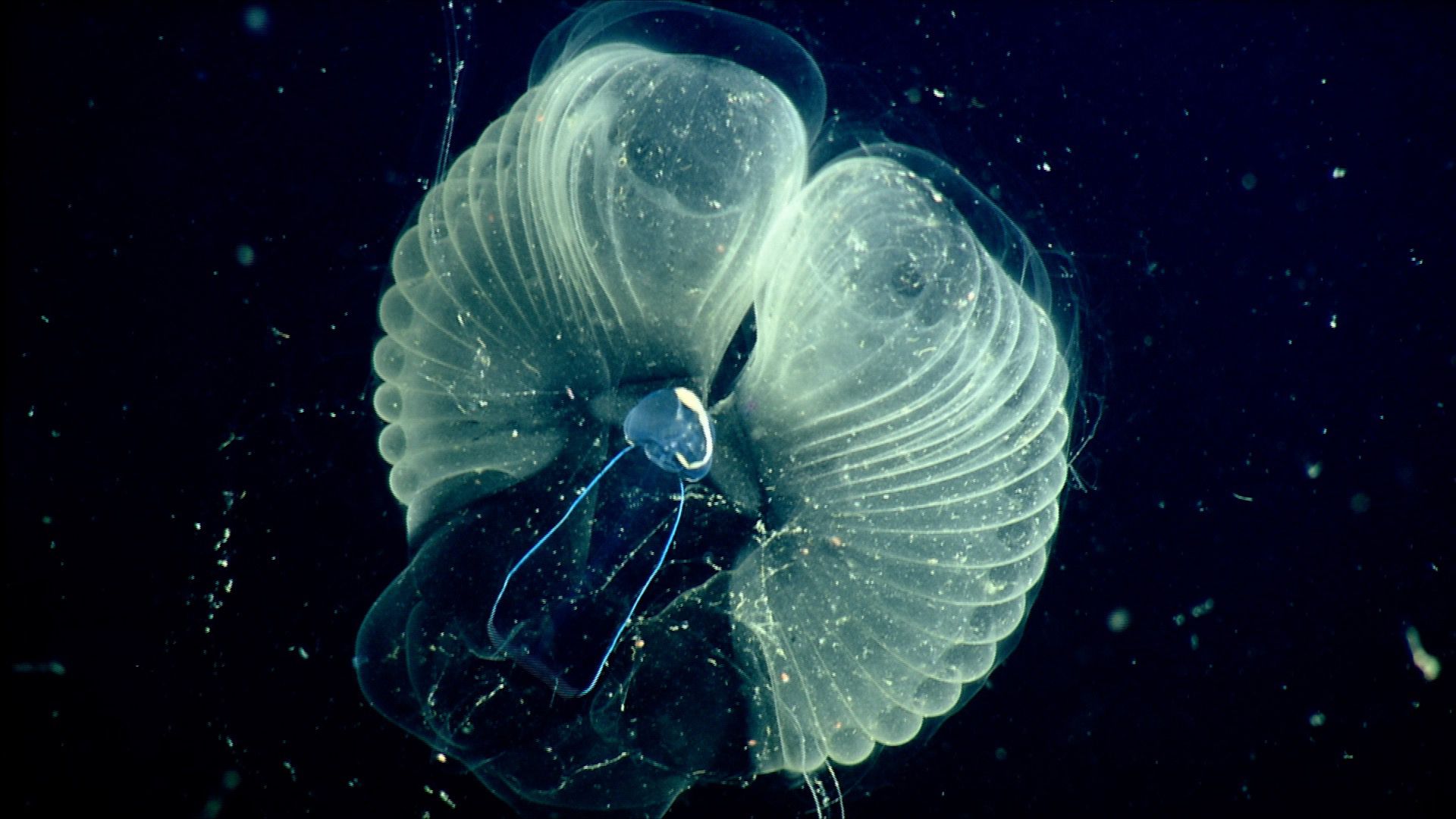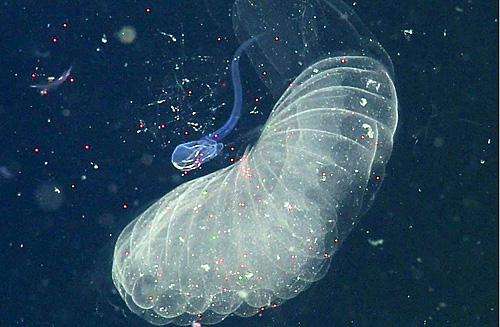- Sustainable Planet -
- 5mins -
- 745 views
From surface to seafloor: How these spectacular creatures transport microplastics to the deep sea
Scientists discover how Giant Larvaceans provide a unique pathway for transporting microplastics down to deep-sea food webs.
Giant Larvaceans discovered to filter Microplastics
Over the past twelve years, scientists have discovered tiny pieces of plastic in many ocean waters, even right down in deep-sea mud. However, they know very little about how micro-plastics are transported within the ocean. A paper by Monterey Bay Aquarium Research Institute (MBARI) researchers in the journal Science Advances shows that filter-feeding animals called giant larvaceans (Bathochordaeus charon) can collect and consume microplastic particles in the deep sea. The particles accumulate in larvaceans’ cast-off filters and are passed into the animals’ fecal pellets, which sink rapidly through the ocean, potentially carrying microplastics to the deep seafloor.

Larvaceans abandon their “houses” when they become clogged with debris
Despite their name, giant larvaceans are less than 10 centimetres (four inches) long, and look a bit like like tadpoles. They live far below the ocean surface, capturing food in sticky mucus filters that can be over a meter (three feet) across. These filters (which are called "houses" because the larvaceans live inside them) trap tiny particles of drifting debris, which are then eaten by the larvacean. When a larvacean’s house becomes clogged with debris, the animal abandons the structure and it sinks toward the seafloor.
In early 2016 MBARI Principal Engineer Kakani Katija was planning an experiment using the DeepPIV system to figure out how quickly giant larvaceans could filter seawater, and what size particles they could capture in their filters. Other researchers have tried to answer these questions in the laboratory by placing tiny plastic beads into tanks with smaller larvaceans. Because giant larvacean houses are too big to study in the lab, Katija decided to perform similar experiments in the open ocean, using MBARI’s remotely operated vehicles.
When Katija discussed this experiment with Postdoctoral Fellow Anela Choy, they realised that such in-situ feeding experiments using plastic beads could also shine light on the fate of microplastics in the deep sea.
In June 2016, the researchers outfitted MBARI’s remotely operated vehicle (ROV) Doc Ricketts with a container of seawater and color-coded plastic spheres of various sizes, from one one-hundredth to two thirds of a millimeter in diameter. After sending the ROV down into Monterey Canyon, the team released small quantities of microplastic beads near the feeding filters of individual giant larvaceans, then pulled the ROV back to watch what happened.
In at least 11 of the 25 larvaceans tested, the beads were trapped by the larvacean’s fine-textured inner filter. In six of these cases, the researchers observed a larvacean actually ingesting the beads, which were visible inside the animal’s transparent body. Continued below…
Source: MBARI.org

results suggest larvacean houses could quickly transport microplastics to sea floor
The researchers used the ROV to capture the six larvaceans with plastic beads in their guts and brought them to a lab on board the research vessel Western Flyer. They kept the animals in the lab for 12 hours. By this time all of the plastic beads had passed through the larvaceans’ guts and ended up in their fecal pellets.
After recording the numbers and sizes of beads embedded in fecal pellets, the researchers were surprised to discover that the larvaceans had collected and consumed particles of all sizes used in the experiments. They had expected the larvaceans to consume only the smaller particles.
The research team then measured how quickly the fecal pellets of giant larvaceans would sink. The fecal pellets were estimated to sink at about 300 meters (about 1,000 feet) per day. Previous studies showed that discarded larvacean houses can sink as rapidly as 800 meters (2,600 feet) a day. These results suggest that larvacean houses and fecal pellets could quickly transport microplastics from near-surface waters to the deep seafloor.
Laboratory studies have shown that other common filter-feeding animals, such as salps, can also ingest microplastics. Katija and Choy and their coauthors are currently conducting ROV experiments to find out if these animals behave similarly in their natural environment. Choy and MBARI Senior Scientist Bruce Robison are particularly interested in how microplastics might be transferred from one animal to another through deep-sea food webs. Continued below…
Source: MBARI.org

many basic questions about microplastics in the ocean remain unanswered
In previous experiments using the DeepPIV system, Katija showed that giant larvaceans can filter seawater faster than any other drifting open-ocean animal. This finding, along with the recent research, suggests that larvaceans have the potential to be important, unintentional consumers of microplastics in the ocean. Because many other deep-sea animals eat larvaceans, their fecal pellets, or their cast-off houses, any microplastics collected by larvaceans would be incorporated in midwater food webs.
Similarly, microplastics that reach the deep seafloor don’t just disappear. Many are likely to be ingested by deep seafloor animals that depend on cast-off larvacean houses as an important source of food.
Katija is quick to point out that the study is just a first step, and many basic questions about microplastics in the ocean remain unanswered. "There’s a lot of work being done studying plastic in the guts of seabirds and fish," Katija said, "But no one has really looked at plastics in deeper water. We’re currently working on experiments to study the concentrations of microplastics at different depths in the ocean, using water samples and maybe even cast-off larvacean houses."
The MBARI team is also actively collaborating with the Monterey Bay Aquarium to communicate the societal and ecosystem impacts of large-scale plastic pollution in the ocean. As Choy put it, "The Aquarium is deeply committed to the conservation of ocean ecosystems, and has vast experience working to influence policy with science. By combining this expertise with MBARI’s knowledge and experience with deep pelagic ecosystems, we’re working to understand the transport and cycling of plastics through ocean food webs, and what this might mean for humans."
Read the paper ‘From the surface to the seafloor: How giant larvaceans transport microplastics into the deep sea.’ — by Kakani Katija, C. Anela Choy, Rob E. Sherlock, Alana D. Sherman and Bruce H. Robison et al.
Source: MBARI.org


